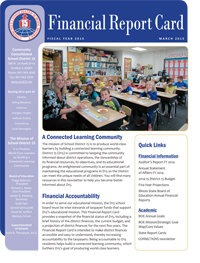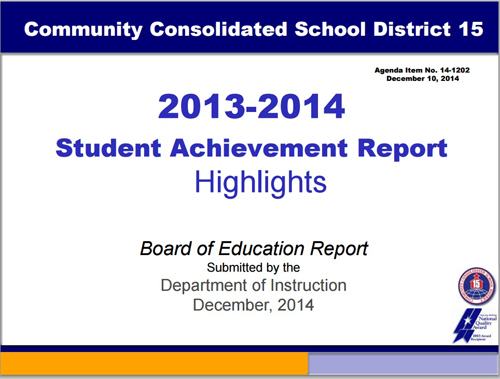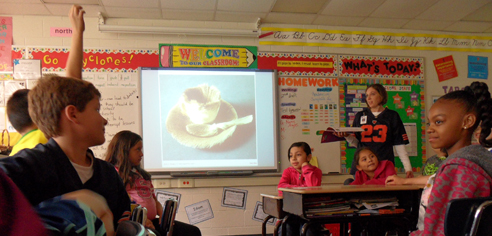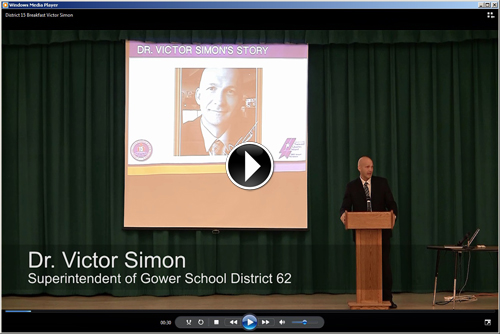|
|
|
 | | Scott B. Thompson, Ed.D. Superintendent of Schools |
From the Superintendent
To meet students' needs -- and the demands of new standards -- District 15 must adopt new curricular materials.
Over the past several years, District 15 teachers and administrators have worked hard to break down the new Common Core State Standards for English, language arts, and math, and implement them in our classrooms with our students. This work -- and our ongoing preparation for the coming adoption of the Next Generation Science Standards and the soon-to-be-developed social studies standards -- has revealed a need for the District to develop a plan for adopting new curricular materials in all of these subject areas.
New materials need to be adopted because the new standards require content and skills to be taught in a different sequence than the 1997 Illinois State Standards that were previously in use in Illinois' public schools. Our teachers have done a wonderful job of using our existing materials and a wide variety of online and teacher-made resources as they have worked to incorporate these new standards into their instruction. Still, a formal adoption of curricular materials is overdue and must be completed in order to adequately prepare our students for success after they leave the District.
The following timeline shows when the first steps in the process of adopting new curricular materials are set to occur for each subject. This process begins with materials in each curricular area being researched to ensure they meet our high standards. Those making the grade will be piloted throughout the District. After the pilot, decisions will be made on the specific set of materials that will be implemented Districtwide and then evaluated throughout the years they are used.
- 2015-16: Math Grades K-8 and Science Grades 6-8
- 2016-17: Science Grades K-5 and Reading Grades K-8
- 2017-18: Social Studies Grades K-8
As we undertake this effort, the District must keep in mind several key facets to a successful curriculum adoption cycle. We must continue to research best practices for teaching and learning within each of these subject areas. We must be sure that all materials considered for piloting and implementation are rigorous in nature and have a research base. All materials must possess both formative assessments, which check for understanding during learning, and summative assessments, which validate that a skill has been mastered at the end of a unit. And we must work closely with our high school districts to make sure our curricula are aligned to provide a smooth and successful transition for all students.
Finally, as we adopt new curriculum materials, we must refine instruction in ways that help our teachers use them to effectively implement best practices in their classrooms with their students. By equipping each of our 20 schools with consistent curricular materials in English, language arts, math, science, and social studies, the District will be able to provide teachers with targeted professional development that will enhance their abilities to deliver the curriculum and meet the challenges presented by all of these rigorous new standards.
The goal of these new standards is for all students to be "college and career ready" at the end of their high school experience. Just like the world we live in, the profession of educating children grows more and more sophisticated with each passing day. Consequently, reaching that lofty goal is more challenging than it has ever been. I am, however, confident that this curriculum work will place the District, its dedicated and skilled teachers, and the students we serve each and every day in the best possible position to successfully achieve that goal.
Sincerely,

Scott B. Thompson, Ed.D.
Superintendent of Schools
|
| To 2025 and Beyond!
The new 10-year life safety study will help District 15 outline how it will address its facilities needs for the foreseeable future.
This winter, District 15 shared the results of its new 10-year life safety study that was performed on its facilities over the summer. Now, its Facilities Plan Committee is refining its recommendations related to the study, and preparing to present them to the District 15 Board of Education during the Board's June 17 meeting.
STR Partners, the District's architect of record, completed a thorough and comprehensive analysis of the facility needs of each of the District's buildings and identified a total of nearly $156 million of facilities projects. Of that total, $24.5 million of the projects are categorized as requiring completion within a year of the report's filing, and another $110.6 million of them are categorized as requiring completion within five years.
After their initial analysis of the report, administrators determined that the District could effectively reduce that $156 million total to about $119 million, as that overall amount includes $20 million of projects categorized as recommendations, $6.2 million of projects related to non-instructional facilities, $4.3 million of projects the District can complete in-house, and $600,000 in savings related to corrected cost calculations.
After sharing these study results, the District conducted four Community Communication Forums that further detailed the results of the survey and allowed residents to provide their feedback. The forums were held at each of the District's four junior highs, and attendees at each forum were presented with detailed study results that pertained to that particular junior high and its feeder elementary schools. Presentations from each of the forums, as well as the study itself, are available in the Decennial Life-Safety Report section of the District's website. The presentations contain categorical breakdowns of all of the projects identified at each of the featured schools, and include photographic examples of some of the facilities concerns identified in the study.
Following the forums, the District convened a Facilities Plan Committee, which met throughout the spring to consider the list of needs at all 20 of District 15's schools, prioritize them, and create a multi-year plan to address the issues and keep the schools functioning as learning spaces.
Since sharing the study in December, Scott Thompson, Ed.D., superintendent of schools, has consistently emphasized that his goal moving forward is for the Board, the Administration, and the District 15 community to use the new life safety study's results to create a comprehensive facilities plan that will outline how the District intends to address its facilities needs for the next decade and beyond.
"These study results will significantly shape the way our schools -- our actual brick and mortar facilities -- will look and function for the foreseeable future," said Dr. Thompson. "They will completely rearrange the way all of our building maintenance and repair projects are prioritized, and, in doing so, will establish the work we will need to do and the challenges we will need to overcome over the course of the next several years."
|
|
Making Dollars Make Sense
 District 15's 2015 Financial Report Card is available online. District 15's 2015 Financial Report Card is available online.
The Financial Report Card is intended to make District finances accessible and easy to understand by providing a snapshot of the financial status of District 15, including a brief history of District finances, the current budget, and a projection of District finances for the next five years.
District 15 is committed to keeping the community informed about District operations, the stewardship of its financial resources, its objectives, and its educational programs. An enlightened community is an essential part of maintaining the educational programs and meeting the unique needs of all children in District 15.
District 15's Financial Report Card, Fiscal Year 2015 has been posted on the District's website: www.ccsd15.net | Our Services | Business & Auxiliary Services | Financial Report Card.
For more information, contact Michael Adamczyk, chief school business official, at 847-963-3032 or adamczm1@ccsd15.net.
|
|
|
Behind the Facts and Figures
Whether you read the document or watch the video, the Department of Instruction's Annual Student Achievement Report will help you understand District 15's strengths and challenges.
 This winter, District 15 released its 2013-14 Annual Student Achievement Report. This annual report is intended to inform the community and enhance its understanding of current District demographic profiles and levels of achievement. This winter, District 15 released its 2013-14 Annual Student Achievement Report. This annual report is intended to inform the community and enhance its understanding of current District demographic profiles and levels of achievement.
The document, itself, is annually praised by the District 15 Board of Education for placing the District's strengths and challenges in proper context through the use of simple language that clearly communicates what are often complex issues behind the facts and figures.
 Similarly, the presentation of the report by Department of Instruction staff is indisputably a highlight of the Board calendar each year. For anyone interested in learning about student achievement in District 15 straight from the District's instructional leaders who understand it best, their engaging and informative presentation is well worth a watch. (The 38-minute presentation begins at the 7:30 mark of the meeting video of the Board's December 10, 2014, regular meeting.) Similarly, the presentation of the report by Department of Instruction staff is indisputably a highlight of the Board calendar each year. For anyone interested in learning about student achievement in District 15 straight from the District's instructional leaders who understand it best, their engaging and informative presentation is well worth a watch. (The 38-minute presentation begins at the 7:30 mark of the meeting video of the Board's December 10, 2014, regular meeting.)
In either format, highlights of the report include shifts in student demographics, student achievement growth and outcomes, and plans to address the increasingly diverse needs of students in the District.
Demographics
District 15 continues to see substantial shifts in its demographic profile, and these shifts provide instructional challenges in its quest for excellence.
For instance, the number of District 15 students coming from economically disadvantaged homes has more than doubled since 2004. Today, 42 percent of the District's students come from low-income families.
Similarly, the percentage of District 15 students with limited proficiency in English has increased from 15.9 percent in 2004 to 22 percent in 2014, and the percentage of minority students has increased from 35.4 percent to 58.8 percent in that same time.
Research has shown that students from these subgroups often have increased risk factors that have been shown to have an influential impact on student achievement. Consequently, decisions regarding student assignment and needs related to staffing, curriculum materials, and professional development will continue to be impacted by these established and ongoing trends.
Growth and Outcomes
Overall, students in District 15 continued to outperform students statewide on the last administration of the Illinois Standard Achievement Test (ISAT) in reading and math. (The ISATs were replaced this year by the Partnership for Assessment of Readiness for College and Careers exam.) As a group, District 15 students also scored higher than the national norm on Measures of Academic Progress (MAP) assessments.
Students in subgroups such as low income, minority status, and limited English proficiency scored at a level that was close to their peers in most subgroups. However, support for the District's Hispanic and limited-English-proficient students remains an area for continued growth and attention.
District 15 student outcomes on the EXPLORE test, which is a predictor of ACT performance, showed that, overall, eighth-grade students from District 15 performed as well or better than the eighth-grade students from other feeder districts that entered high school in Township High School District 211 this year.
Future Focus
As the student population continues to change in District 15, agility and responsiveness to the needs of individual students and groups of students is emphasized.
The District has made it possible for more students to benefit from specialists and instructional coaches this school year by having these professionals "push-in" to classrooms to work collaboratively with classroom teachers to strengthen the core curriculum. This approach to providing professional support services has allowed for more students and teachers to benefit from the expertise and instruction of our specialists.
Interventions are available for students who need additional targeted support in reading in English and Spanish, as well as in math and oral language development. District 15 intervention models include small-group instruction, classroom-based instruction, and, when necessary, one-on-one instruction. Extended Day Kindergarten, a program for students who are at risk for academic difficulty, is in its third year of implementation, and the student's outcomes are extremely favorable.
|
Stop Remediating, Start Engaging
That's how the District's new "Reading and Identity" classes have succeeded at connecting with struggling junior high students in meaningful ways.
Last year, Cheryl Wolfel, Ed.D., District 15's director of second language programs, and René Carranza, Winston Campus Junior High's principal, found themselves facing a dilemma: what to do with a group of a dozen male Latino students who -- simply put -- were disengaged from school.
"They had been in and out of every intervention available to them, and were still reading at second- or third-grade levels as seventh graders," said Dr. Wolfel.
Together, Dr. Wolfel and Mr. Carranza worked with Winston's bilingual staff to analyze data and pore over research and literature, searching for ways to reach those students. What they ultimately concluded was that they had to put the past behind them and let the research of Dr. Alfred W. Tatum, dean of the University of Illinois at Chicago's College of Education and director of the UIC Reading Clinic, be their guide.
"We decided we had to stop remediating and start engaging them in a unique way that wasn't skill based," said Dr. Wolfel. "We had to engage them in a way that meant something to them -- that resonated with them."
Dr. Tatum's qualitative research with struggling high school readers -- male African American adolescents, in particular -- makes the case that using diverse and challenging texts that matter to these students could reshape their life outcomes. In his article titled Enabling Texts: Texts That Matter, Dr. Tatum describes how he asked 120 students in Boston Public Schools to construct visual representations of texts they had found to be significant in their lives. On average, the students identified two texts that held significance throughout their entire, albeit young, teenage lives. The reasons the texts held significance, he concluded, converged on three major themes: personal connection, empathy, and identity shaping.
"The students ascribed the absence of meaningful texts in their lives to teachers' refusal to acknowledge their day-to-day realities couched in their adolescent, cultural, and gender identities," stated Dr. Tatum.
That's why Dr. Wolfel and company decided to create a gender-based class of no more than 15 hand-picked students that would be under the guidance of a bilingual teacher who would use the Socratic Method as the principal approach to learning in the class. Together, the students would read and discuss -- in either English or Spanish -- authentic literature that this group of educators believed the students would actually be interested in studying. They called this new endeavor a "Reading and Identity" class, and they kicked off this course by studying Charles Mann's Before Columbus: The Americas of 1491, which explores the Toltec, Olmec, and Aztec civilizations.
"Even though they had already studied ancient civilizations in social studies, these boys took to this book immediately, and they remained engaged from there on, picking the topics they wanted to study, and finishing off the school year reading a book about quantum mechanics of all things," said Dr. Wolfel.
Of the 12 boys in the class, 10 met or exceeded state reading standards at the end of the year, proving -- said Dr. Wolfel -- that they could indeed read; they just weren't interested in what they were reading. In addition, the fact that the students could respond in English or Spanish helped them negotiate meaning.
That "Reading and Identity" class proved so successful and popular that the District expanded the program this year. It added a class of hand-picked Latina students at Winston Campus, and created male and female sections at Carl Sandburg Junior High. Additionally, a sixth-grade version of the class is likely to be implemented at one of the District's elementary schools next year.
"Kids now want to be in this class. They're telling us that they want to be smart, and that they want to read college textbooks, too," said Dr. Wolfel. "In surveys that we conducted, parents of this initial group of boys also indicated they loved the class because it gave them something to talk about with their sons, who were always excited to discuss what they'd learned with their parents and pepper them with questions every night."
|
|
Speaking Engagements
Common Core's renewed emphasis on oral language development brings three exciting programs to the forefront of classroom instruction.
From the outset, it was evident to educators all across the country who were preparing for Common Core's arrival that the new standards would require them to place greater emphasis on oral language development -- on developing students' abilities to speak fluently, discuss ideas among their peers, and argue and support their points of view.
That shift is a good thing, said Maria McClurkin, Ed.D., District 15's director of literacy programs.
"We know from research that oral language development is really the foundation of all literacy," said Dr. McClurkin. "So we're working very hard on helping both our bilingual and monolingual students develop their oral language skills."
Let's Talk About It
Prior to Common Core, the Illinois State Standards that were developed in 1997 primarily addressed oral language development at the lower grade levels. So, for several years now, the District has used a supplemental program called "Let's Talk About It!" with its primary students in kindergarten through third grade to help develop their oral language abilities. Now this program is playing a more prominent role in instruction across the District.
"Let's Talk About It!" provides a sequential, structured approach for oral language development. A five-minute oral language screening identifies students' understanding and control of English language structures, and small-group instruction uses engaging photos, text cards, and detailed lesson plans to support further language development.
In the program's oral language -- reading sessions, teachers encourage students to talk about different photos, and then they record students' ideas to read back to them, This reinforces the concept that what students think, they can also say, and that what they say can be recorded and read. The program's oral language -- writing sessions build on this language work as students share in recording their thoughts for themselves. As their academic language structures and vocabulary develop, students comprehend more complex spoken and written language and learn to think logically, arrange ideas, solve problems, and draw conclusions.
Discussions4Learning
In addition to the "Let's Talk About It!" program, District 15 introduced a new supplemental oral language development program earlier this winter. Called "Discussions4Learning," this engaging oral language program accelerates students' vocabulary acquisition through lively discussions about fine art and real-world photos.

Just as adults might take children to a museum or park and discuss the experience during or after the visit, the works of fine art and real-world photographs from around the world that comprise the visual foundation of the "Discussions4Learning" program provide a time- and cost-efficient "field trip." Carefully chosen for their visual impact, their thought-provoking content, and their appeal for students, these images -- which represent diverse cultures, time periods, art media, and perspectives -- capture the attention of all students, regardless of their age or linguistic proficiency. Each image, whether fine art or real-world photography, is rich in meaning and content, and offers countless avenues of discussion to explore with students.
As students share and discuss their experiences with the images, they begin to use a wide variety of vocabulary words that are rarely found on elementary-level study lists, but are likely to be encountered in other contexts. At the same time, the fine art and real-world photo pairings deepen students' understanding not only of language, but also of a wide range of human experiences, occupations, activities, and values.
Word Generation
This year, the District has also introduced the "Word Generation" program, which employs an innovative approach to oral language development for intermediate and junior high students. The "Word Generation" program actually focuses on developing students' academic vocabulary by exposing them to words they are likely to encounter in textbooks and on tests, but not in spoken language. Interpret, prohibit, vary, function, and hypothesis are examples of such language.
Each week's "Word Generation" unit introduces five high-utility academic words embedded in articles about engaging topics that summarize national or local controversies currently under debate and often in the news. These passages, which are often supplemented with video footage and reader's theater activities, enable students to join broader conversations that are occurring around the world by sparking active examination and discussion about contemporary issues that interest them. Multiple perspectives are provided on each "Word Generation" topic, and students are provided with evidence that supports each perspective.
Students discuss or debate each week's issue, supporting their positions with evidence and responding to the reasoning of others. Students enjoy debating these important issues with their classmates -- it motivates them to carefully read the text and collect evidence to defend their positions and rebut contrary views. Because students' verbal arguments are typically more advanced than their written ones, these discussions and debates ultimately lead to assignments that require students to put their arguments into writing. Often, those assignments reveal that the challenge of orally articulating their arguments improved the work the students produced as writers.
|
| Made in District 15
Victor Simon shares how his experiences in District 15 helped prepare him to become Gower School District 62's superintendent.

Name: Victor Simon
District 15 History: In 1985, Victor and his family moved into a public housing community on the District's northeast side. It was at least the 15th time in his young life that he'd had to move, and it was a difficult -- and at times abusive and even violent -- period in his life when he didn't know where home was going to be, or who was going to be home when he got there. During this time, he went to sixth grade at Gray M. Sanborn School, and seventh and eighth grade at Walter R. Sundling Junior High. He was attending Palatine High School when his family once again had to move. By the time he graduated from Curie Metropolitan High School in Chicago, he'd moved 19 times. Although he only attended District 15 schools for three years, they were three years that had a tremendous impact on the trajectory of his life and career.
Further Education: After he graduated from high school, Victor went on to earn a bachelor's degree in biology from Illinois Wesleyan University, a master's degree in leadership and administration from University of Illinois at Chicago (UIC), and a doctorate in urban education leadership from UIC.
Current Occupation: Victor taught science for seven years at Whitney Young High School in Chicago, and served for five years as principal at Dore Elementary School on Chicago's southwest side before becoming the chief of schools for Chicago Public Schools' Pershing Elementary School Network. In this role, he oversaw approximately 21,000 students in 31 of Chicago Public Schools' facilities in such neighborhoods as Englewood, Back of the Yards, and Brighton Park. Two years ago, he accepted his current position as superintendent of Gower School District 62, a two-school, 900-student district in Willowbrook and Burr Ridge.
 In His Own Words: In His Own Words:
Earlier this year, Victor shared his story during a District 15 Community Breakfast. While his remarks can be viewed in their entirety here, several highlights have been transcribed below:
-
"I got here in sixth grade, and that was the first time that I really realized I was poor. I didn't know. I didn't know that other kids had stuff like multiple outfits to wear to school -- multiple pairs of shoes and jeans and things like that. ... "
"I remember that year well because our teacher at the time wanted to do our own video of the Super Bowl Shuffle. ... I wanted to be Speedy Willie. I wanted to be Willie Gault. ... We had a quick little practice, and that's when I realized everyone had the football jerseys. They all looked like the Bears, and I didn't. I had a T-shirt on, and I figured, 'What the heck? I know the lyrics. I can be Speedy Willie, too.' Well, the teacher helped me out by just taking a Magic Marker and putting 83 on the back of the T-shirt, and I felt like, 'All right.' I pulled it off.'"
-
"So I get to eighth grade ... at that point, I was still a bit rambunctious ... but I have a teacher (Dave Havell) that takes the time to say ... 'You know, I believe in you. I think that instead of putting all of this energy into things that might not be so productive, you should put some energy into this test, or you should put some energy into wrestling, or you should put some energy into being a better student. That kind of stuff.' And it just sort of confused me, right? As a 13-year-old, I'm thinking, 'Well, wait a second. I'm getting a lot more attention being a knucklehead. I have all of my friends. I don't need to hear all of this sort of positive stuff.' That was the first time that I was really dealing with that, but he wouldn't let it go. ... "
"Wrestling wasn't going to work out, but the grades did, and this was the first opportunity I had to be successful in a classroom. It was eighth grade, and it was the first time that I'd come across a male role model in my life. ... When I was greeted with a firm handshake by Mr. Havell in the morning, that was the first time that I actually ever did a handshake. We were always fist bumping and chest bumping and doing all of that other kind of stuff. That was the first time that I had someone stop and say, 'This is how you shake a hand, and good morning. I'm glad you're here. I hope you're going to work hard for me today.'"
-
"I know that without the influence of two teachers that I had, it is a completely different route (for me). ... "
"So it starts in the classroom. I didn't wake up one day and say, 'All right, it's going to be educator for me.' ... That's not the case at all. It is definitely something that I take a lot of pride in to work with students on a regular basis, and I know that I owe it to a handful of educators."
"With that, I'd like to just close and say thank you to this community. I wasn't here long, but the years that I was a student in (District) 15, they were impactful. They made a difference. They make a difference every single day."
|
|
|
|
|